The U.S. Experience with Provincial Reconstruction Teams in Iraq and Afghanistan
Testimony of Robert Perito, U.S. Institute of Peace senior program officer in the Center for Post-Conflict Peace and Stability Operations, before the House Armed Services Subcommittee on Oversight and Investigations.
Robert Perito testified before the House Armed Services Subcommittee on Oversight and Investigations alongside the Special Inspector General for Iraq Reconstruction, Stuart Bowen. Perito summarized the three functions PRTs perform—governance, reconstruction and security—and offered recommendations to improve their operations and effectiveness.
Mr. Chairman and Members of the Subcommittee, I appreciate the invitation to testify before this subcommittee on the U.S. experience with Provincial Reconstruction Teams (PRT) in Iraq and Afghanistan. I am Robert Perito, Senior Program Officer in Center for Post Conflict Peace and Stability Operations at the U.S. Institute of Peace (USIP). I would like to share with you my observations about the effectiveness of PRTs and offer four recommendations on ways to improve the PRT program. These are my own views and not those of USIP, which does not advocate specific policy positions.
Scope and Mission of the PRT Program
Provincial Reconstruction Teams (PRTs) are small, civilian-military units that assist provincial and local governments to govern more effectively and deliver essential services. The first PRTs were established by the U.S. in Afghanistan in 2002. The purpose was to combine military leadership with representatives of civilian government agencies, Army Civil Affairs teams and force protection units to enable civilian agencies to operate in insecure areas. There are now 25 PRTs in Afghanistan operating under the NATO-led International Security Assistance Force, (ISAF). These PRTs are led by the U.S. and 12 other NATO and Coalition partners; another dozen countries contribute personnel, financial and material support.
On November 11, 2005, Secretary of State Condoleezza Rice inaugurated the first of ten PRTs in Iraq. In Iraq, PRTs are led by the State Department and staffed primarily with civilians, including private contractors. On January 10. 2007, the President announced the creation of ten additional PRTs as part of the “New Way Forward.” These “e-PRTs” were embedded in U.S. military brigade combat teams (BCT) operating in Baghdad and Anbar Province. There are now 25 PRTS operating in Iraq. Included in this number are three PRTs led by our Coalition partners: the UK, Italy, and South Korea.

Robert Perito testifies before the House Armed Services Subcommittee on Oversight and Investigations.
In Afghanistan, the PRT’s mission is to help extend the authority of the Afghan government into the provinces in order to develop a stable and security environment, enable security sector reform and economic and social development. PRTs are located in provincial capitals where they interact primarily with the governor, provincial level representatives of the central government ministries and elected provincial councils. Their task is to help insure that traditionally strong local authorities promote the aims of the central government and not pursue independent agendas.
In Iraq, PRTs are expected to assist Iraqi provincial and municipal officials and civil society groups to improve governance, reconstruction and security through capacity building and by creating political space for moderates to operate. PRTs are also expected to assist the U.S. military by providing the political component of the U.S. counterinsurgency strategy. The role of PRTs is to help strengthen provincial authorities and assist them in undertaking local initiatives in an historically centralized state.
PRT Organizations Differ Widely
Beyond contrasting missions, PRTs in Afghanistan and Iraq have a variety of organizational structures. The U.S. has three models of PRTs:
- In Afghanistan, the U.S. model for PRTs has 80 personnel: three are civilians representing the State Department, USAID and the Department of Agriculture. The military component includes the PRT commander and his staff; a force protection unit (usually an infantry platoon of National Guard); two Army Civil Affairs teams, each with four soldiers; and several small units of military police, intelligence officers and other specialists. Not all U.S. PRTs have all these parts.
- In Iraq, the original ten U.S. PRTs were led by a senior Foreign Service Officer and had up to 80 mostly civilian personnel from the Departments of State, Justice, Agriculture and USAID. The military component included the deputy leader and military liaison officer, civil affairs soldiers that performed various functions and a representative from the Army Corps of Engineers. The PRT also included USAID civilian contractors and Iraqi personnel. For these PRTs, force protection was provided by the U.S. military or contact security.
- The new embedded PRTs (e-PRT) feature are led by a State Department Official who is one of a four-member core group that also includes a representative from USAID, Army Civil Affairs and a cultural advisor/translator. E-PRTs may have a mix of 8-12 civilian subject matter specialists depending on local requirements and there may be military officers assigned directly to the PRT. This year most civilian slots in e-PRTs were filled by members of the National Guard and Army Reserve. The State Department is now recruiting replacement civilian contractors who will begin arriving in Iraq in November. The changeover from military personnel to contractors will be completed by next summer. The BCT commander is responsible for security and movement. His troops provide force protection for PRT personnel.
In Afghanistan, the U.S. followed the practice of handing off established PRTs to NATO and Coalition partners. These nations often invited other countries to contribute personnel. The result was the proliferation of organizational structures reflecting national policy preferences and bureaucratic configurations. As an example, German PRTs are large with over 300 personnel and a sharp division between a robust civilian development component and a small, highly restricted military unit.
PRT Operations Reflect Locales

Robert Perito shakes hands with Congressman Vic Snyder (D-AR), chairman of the House Armed Services Subcommittee on Oversight and Investigations.
In Iraq, U.S. PRTs receive operational guidance and policy direction from the newly established Embassy Office of Provincial Affairs and support on military and logistics from the Multi-National Force Iraq headquartered in Baghdad. In Afghanistan, PRTs receive operational direction and policy guidance from the PRT Executive Steering Committee in Kabul, which is co-chaired by the Afghan minister of the interior and the commander of ISAF. Operational issues are addressed by a subordinate PRT Working Group, which also includes the UN and relative embassy representatives. ISAF has produced a PRT Handbook that provides general guidance and useful information on the organization and work of PRTs. For Iraq, the Army Lessons Learned Center has posted a PRT Playbook on its website, but this document has not been cleared by the civilian government agencies that participated in the drafting process.
In fact, beyond the mission statement, there is no agreement within the U.S. government or between the U.S. and its allies on how PRTs should be organized, conduct operations or what they should accomplish. Actual decisions on priorities and programs reflect local conditions along with national priorities of participating governments. In Afghanistan, PRTs located in the relatively peaceful north and west of the country conduct classic peacekeeping operations and emphasize economic development and reconstruction of essential infrastructure. In the south and east along the border with Pakistan, PRTs are engaged in counter insurgency operations to counter the Taliban resurgence. In Iraq, the original ten PRTs have been highly restricted by security conditions and by the early inability of the State and Defense Departments to agree on arrangement for administrative and logistics support and for providing security. Within the past year, these PRTs have expanded operations following a February 2007 memorandum of understanding between State and Defense on support of PRT operations. The new e-PRTs function as part of the BCT commander’s staff and have benefited in terms of receiving administrative and logistic support from this close association with the military.
In both Afghanistan and Iraq, PRT operations are strongly influenced by the personalities of team members. PRT have a bifurcated chain of command with the State Department in charge of political and economic issues and the military responsible for security and movement. Operational priorities often reflect the personal expertise and interests of team members and can change with the rotation of personnel. They also reflect the ability of team members to work together and compromise on common objectives. With no one in overall charge, disputes are referred to more senior officials up separate ‘stovepipes’ of authority. Given the limitations on PRT resources even seemingly small decisions can be important. For example, since all movements “out side the wire” require force protection, decisions on the availability and scheduling of security escorts can significantly affect the ability of PRT members to perform their functions.
In Iraq, the creation of the new Office of Provincial Affairs (OPA) in Embassy Baghdad has yet to fully resolve the problem of coordinating PRT operations. OPA got off to a rocky start, but has improved its performance under new leadership. Similarly, the new e-PRTs, which operate at the sub-provincial level, have had problems coordinating with the original PRTs in Baghdad and Anbar, which have responsibilities for the entire province. E-PRTs report to the Embassy bypassing the provincial PRTs. This has created disconnects in reporting and project development and implementation.
In both Iraq and Afghanistan have suffered from the inability of U.S. civilian government agencies to provide personnel. The State Department has been able to fill its limited number of assigned slots, but has been forced to rely upon junior officers, retirees or civil servants Most USAID slots are filled with contract personnel who often have only a limited knowledge of their sponsoring agency and government regulations and requirements. Other U.S. civilian agencies have relied on random volunteers or have opted out entirely.
PRTs Have Three Essential Functions
While emphasis may vary, all PRTs concentrate on three essential functions: governance, reconstruction and security.
Governance: In Iraq the primary focus of PRTs has been to improve the ability of provincial and sub-provincial governments to function effectively and provide essential services. USAID civilian contractors provide training and technical assistance in strategic planning, budgets, management and project implementation. Where they are successful, PRTs are able to facilitate cooperation between the provincial governor, representatives of central government ministries and elected provincial councils. They are also able to prod the central government into approving provincial project proposals and releasing funds for project implementation. Among the primary challenges is getting local authorities to assume responsibility and to take initiatives in the absence of laws, regulations and enforcement mechanisms that provide for accountability. In turn, e-PRTs that operate at the sub-provincial level are able to get district and municipal governments to coordinate effectively and to prod provincial governments to make funds available for implementing projects.
In Afghanistan, PRTs efforts to promote good governance have involved working with the provincial governor and police chief who are appointed by the central government. In cases where these officials are competent administrators and support central government programs, PRTs have provided logistic and financial support. PRT commander have escorted provincial governors on tours and have undertaken infrastructure improvement projects designed to reflect favorably on local authorities. In cases where local authorities are corrupt, involved in the drug trade or have their own agendas, PRTs have either been stymied or have used their influence with higher U.S. authorities to try to remove these officials.
Reconstruction: In Iraq, PRTs play an important role in Provincial Reconstruction Development Committees (PRDC) that include Iraqi officials. PRDCs identify and prioritize provincial development projects, obtain approval, insure they receive funding and oversee implementation. The focus of these projects is primarily on job creation through the development of local businesses and industrial and commercial enterprises. PRT resources come from the Commander’s Emergency Response Program (CERP), the Development Fund for Iraq and the Iraq Relief and Reconstruction Fund. Recently, the State Department has initiated a Quick Response Fund, which enables the PRT leader to make small, quick dispersing grants to enterprises and civil society organizations to promote economic and social development. It should be understood, however, that PRTs exist in a larger assistance universe and must conform to national level development assistance plans. There is no shortage of development assistance funding in Iraq. The challenge has been to encourage the Iraqi government to release funding obtained from petroleum and other revenue sources for provincial development efforts.
In Afghanistan, PRTs initially focused on quick impact village improvement projects designed to demonstrate goodwill and encourage a favorable local reaction to the presence of foreign military units in rural areas. At times, PRT projects, which were implemented through local contractors, were ill advised, leading to shoddy construction and the building of schools without teachers and clinics without medical personnel. Such efforts produced criticism from private humanitarian and relief agencies. They argued that involvement of soldiers in development violated “humanitarian space” and endangered the aura of neutrality that relief workers relied on for their protection.
Over time, particularly following the arrival of USAID representatives, PRT projects conformed to provincial and national level development plans. As in Iraq, PRTs rely on CERP and a variety of other sources for development funding. Effective PRTs are expert at mixing funding sources to accomplish their objectives. Increasingly, PRTs have tried to use development aid to neutralize local sources of conflict and to provide incentives for Afghans to oppose the Taliban. Here again, PRTs operate in a larger ‘aid universe.’ PRT are responsible for only a small percent of the U.S. assistance budget and have limited influence over projects that are supervised from the U.S. Embassy in Kabul.
Security: In Afghanistan, PRTs are part of the security presence in their areas of operation, but they have no offensive capability and their only security function is force protection. PRT military elements provide convoy security for movements of PRT personnel. PRTs are co-located with U.S. and Afghan combat units on which they rely for protection from hostile forces. PRTs have no responsibility for counter narcotics or other types of law enforcement. They can contribute to local security by funding construction of police stations and providing equipment and advice to Afghan police and military units.
In Iraq, eight of the first ten PRTs were located on U.S. Forward Operating Bases and relied upon the U.S. military for convoy escort and force protection. Since the February 2007 memorandum of understanding between State and Defense, U.S. commanders have more willingly provided dedicated armored vehicles and soldiers trained in providing close protection for civilian personnel. This is in contrast to an earlier period when U.S. military escorts stood and fought when attacked rather than rushing their civilian charges to safety or combined PRT escort service with counter insurgency patrols. Provision of military security for PRTs has virtually eliminated State Department’s reliance upon private contract security guards with a resulting improvement in service and a marked reduction in cost. E-PRTs are part of the brigade structure and rely upon the brigade commander to provide for their protection. Civilians serving in e-PRTs remain subject to highly restrictive State Department Diplomatic Security regulations, but, in fact, more lenient Defense Department security regulations actually apply. This permits e-PRT personnel to operate more effectively and to more often engage directly with Iraqi officials.
Conclusions and Recommendations
While U.S. PRTs vary greatly in size, organization and functions, they share several common problems, which require immediate attention. These can be summarized as follows:
- Improvisation is not a concept of operations: PRTs need an agreed concept of operations and organizational structure with a single chain of command. This should be developed by concerned agencies in Washington and vetted with the field and our allies. It is unfair to expect personnel from various government agencies and the military to agree among themselves on mission priorities in the most difficult operating environments without such guidance.
- Stability Operations is not a game for ‘pick up’ teams: U.S. civilian agencies need to recruit federal employees with the expertise and skills required to staff PRTs. These permanent agency representatives can train and serve alongside their military counterparts and effectively represent their agencies. This is not possible using commercial contractors or relying upon military reservists to staff civilian functions.
- Silence is not a public information program: The U.S. PRT program suffers from a lack of public information on the nature and results of its efforts. This month, USAID published a magazine, Iraq PRTs, in English and Arabic, which details the activities of PRTs in Iraq. This initiative is commendable but long overdue. In the overwhelming wave of media reporting on Iraq and Afghanistan there are few reports on PRTs. This seemingly is the result of the fact that information is either classified or not readily available.
- Without agreed objectives it is difficult to judge effectiveness: There is a need for both an agreed set of objectives for PRTs and an agreed set of metrics for measuring their performance. Absent a means of determining whether PRTs are effective, it is difficult to determine whether alternative mechanisms might better achieve our purposes. Lack of a means of evaluating PRTs has not prevented their proliferation in Iraq and Afghanistan and talk of creating them in various new operations. Before this occurs, it is time for some objective scrutiny measures of effectiveness.
In this regard, I would like to express my appreciation to you Mr. Chairman, and the Subcommittee for holding this series of hearings on the PRT program. I look forward to your questions.
The views expressed in this testimony are those of the author, not the U.S. Institute of Peace, which does not take positions on policy issues.



